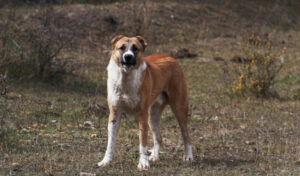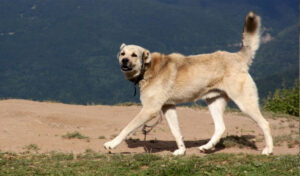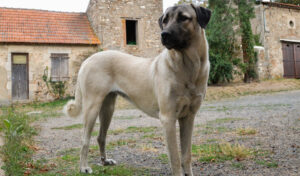What is a Anatolian Shepherd Dog Breed?
The Anatolian Shepherd Dogs are intelligent, serious, capable workers with a strong instinct for self-preservation. They are the protectors of magnificent flocks of sheep with a long history. Anatolians are from some of the earliest known domestic dog lineages.
They are receptive, dedicated, quick to react and flexible. They will loyally defend their herds, animals, children, small pets and even house cats. This breed maintains its working character, wary of strangers and ready to respond to any perceived threat.
These are livestock guard dogs born in Turkey that are still employed by nomadic people who travel in search of food and other resources.
Content Overview
- History
- Different names
- Appearance and Characteristics
- Personality and Temperament
- Health & problems
- How to take care
- Puppy Information
- Puppy price
- Things to consider adopting a puppy
- Advantages & Disadvantages
- Photo gallery
Anatolian Shepherd Dog History
The Anatolian Shepherd is a breed native to Asia Minor. He acts as the shepherd’s companion and guardian of the flocks. The Anatolian Shepherd’s ancestors served as hunting and fighting dogs for generations. It is still employed today as a guard dog and sheep dog.
Because of their close relationship with the Kangal dog, some individuals claim that all Turkish shepherds, including the Kangal dog, belong to the same breed. Unlike the common Turkish dog, Turkish Kangal dogs are claimed to be a separate breed.
The breed saw a breakthrough in the 1970s when Lt. Robert Ballard imported a pair of Anatolian Shepherds from Turkey to the US. They were brought back and raised. The Endangered Species Act, which was established in 1973, made the Anatolian Shepherd more labor intensive to herd.
The main purpose of Anatolian Shepherd dogs is still to serve as working shepherds. In 1995 the AKC approved the Anatolian Shepherd.
Different Names or Types
Anatolian Shepherd Dog Other Names
- Kangal Shepherd Dog
- Kangal Çoban Köpeği
- Turkish Kangal Dog
Recognized Names
Recognitions
- ACA: American Canine Association Inc.
- ACR: American Canine Registry
- AKC: American Kennel Club
- DRA: Dog Registry of America, Inc.
- FCI: Federation Cynologique Internationale
- UKC: United Kennel Club
Appearance & Characteristics
The Anatolian Shepherd Dog is a large and strong livestock guard. Many people associate the Anatolian Shepherd Dog with the Kuvasz and the Great Pyrenees, but the Anatolian is slimmer and more agile. It has a short hair coat that hides a luxurious undercoat in addition to its densely muscled body. This combo makes the dog look big and heavy.
The head is large and powerful, somewhat rounded, in good proportion to the rest of the body with a small stop. The cannon is frequently rectangular and black in color. Black lips with a little downward slant. They frequently have very short-cropped ears.
Medium-sized, almond-shaped eyes range in hue from dark brown to bright amber. An example of a scissor bite is teeth. Neck is broad, slightly arched, strong, muscular, and slack. The elbows are reached by the deep chest.
The back is strong, lean, and level; short in relation to the length of the legs. When calm, the Anatolian Shepherd’s tail is high and carried with a downward curve at the end.
Breed Basic Characteristics
- Country of origin: Turkey
- Breed group: Working
- Life span:11-13 Years
- Size: Extra Large
- Height: 27-29 Inch
- Weight: 80-150 Pound
- Coat: Short, Medium
- Type: Purebred
- Shedding: Occasional
- Colors: White, Brindle, Blue Fawn, White & Biscuit, Liver, Red Fawn
- Also as known: Turkish Koban Köpeği
- Good with children: Yes
- Personality traits: Aloof, Loyal, Alert, Protective
- Good with pets: Yes
- Barking: Frequent
- Competitive registration: AKC, UKC, FCI, ACA ACR, DRA
- Eyes: They have almond-shaped, brown to amber-colored eyes.
- Ears: They have six-inch-long floppy ears
- Body: Strong Body
Coat
The Anatolian Shepherd Dog has a short coat with a dense undercoat. Ears, legs and tail are occasionally feathered. Its coat can be pinto, white or brindle, but the most characteristic variation is the fawn with a black mask.
Color and Markings
Common coat colors for this Breed include.
- Blue Fawn
- Brindle
- Fawn
- Liver
- Red Fawn
- White
- Biscuit & White
- Gray Fawn
Coat Color and Markings
The face is covered with a black or brown mask, and the short coat of fur is thick, especially around the neck and limbs.
Personality and Temperament of Anatolian Shepherd Dog
The Anatolian Shepherd is kind and devoted to those they know, including relatives. Anatolians might be hesitant to warm up to outsiders because to their affection and dedication for their families. The Anatolian is best suited for an experienced owner because to its independence.
They are intelligent enough to swiftly take up new information and skills. They tend to bark at night and are independent, calm, steady, and brave but not aggressive. These consider themselves to be always on duty and zealously guard their family and flock.
They don’t want to talk to strangers and are quite reticent among individuals who aren’t family. Many elements, including as heredity, training, and socialization, have an impact on temperament. Puppies with good dispositions are interested, lively, eager to approach and interact with humans.
Early socialization and obedience training are crucial for a number of reasons. Having an Anatolian in the house will need you to instill in them the idea that strangers are not fearful as early as feasible.
Activity Requirements
The Anatolian Shepherd Dog is a working breed, thus they just need modest activity. The long walk or game of fetch in a secure garden is ideal for the breed. Always keep the Anatolian Shepherd on a leash or in a gated yard when you are outside.
The Anatolian will be content with up to two hours each day, split between two walks, but the following time should be used for interactive training and brainteasers. This breed need room to wander and does not fare well in confined areas like flats.
He should ideally have access to a yard that is safely fenced so he may get some exercise. Every time an Anatolian is put outside, they must be restrained. The dog will be trustworthy to handle. This breed should have slow increases in fitness until maturity due to its size. Playthings that involve puzzles may stimulate the mind and get you moving.
Trainability
Every dog has to be trained. They might be challenging to train due to their reputation as autonomous employees. The key is early and appropriate socializing. A strong recall has to be taught and updated frequently.
Early socialization and training are crucial to keeping this tendency under control. Training in obedience is essential while raising an Anatolian Shepherd. Basic commands like sit, remain, and come are taught during obedience training, and the dog also learns how to walk politely on a leash.
Health & Problems
The Anatolian Shepherds are generally healthy, but like all breeds, they are susceptible to certain health conditions. It is an overall healthy and hardy breed. Although they live longer than average, Anatolian shepherds suffer from some common health conditions.
Hip Dysplasia: This inherited problem causes the hip joint to not fit firmly into the thigh bone. Some dogs may have pain and lameness in one or both of their hind legs.
Elbow Dysplasia: This condition also has a degenerative nature, like hip dysplasia. It is thought to be brought on by deformed and weak joints as a result of aberrant growth and development.
Demodectic mange: Demodex mite is the culprit behind this disease. Humans and other dogs cannot contract ticks. This mite can only be passed from mother to her child.
Entropion: The lower eyelids of both eyes are often affected by entropion, which is an inward tilting of the eyelids. It irritates people and impairs vision.
Feeding Plan
Anatolian Shepherd require specific amounts of food depending on their size, age and activity level. Compared to lesser breeds of dog, they require more because they are a larger breed.
The Anatolian Shepherd puppy is still growing and needs plenty of food. It should be fed about 2-3 cups three times a day. Feed them only puppy food that has the right nutrition for growth and development.
An adult Anatolian Shepherd should generally have 3-4 cups of adult dog chow three times a day. If they engage in high levels of exercise, their normal meal size should be increased as needed. Don’t overfeed them because doing so will just cause them to acquire weight and eventually become obese.
Living Conditions
The best example of what we call a guard dog is the Anatolian shepherd dog. They don’t get tired or agitated from standing on their long, powerful legs all day to protect their offspring. These dogs often get along well with children and other pets in the household, but only if they have been raised that way.
Early socialization and training are crucial because of their highly insecure personalities and independent mindsets. The Anatolian Shepherd Dog can exhibit destructive tendencies such as excessive barking, chewing and digging and is extremely challenging to train.
These Dogs need a lot of activity because their ancestors were herd guardians. Anatolian shepherds favor rural and outdoor lifestyles rather than urban lifestyles for similar reasons. If you have a big house with a big yard to run around in it will live there happily.
Also Read: Shiloh Shepherd Dog Breed
How to Take Care of Anatolian Shepherd Dog?
Anatolian Shepherd Dog grooming is critical. The Anatolian is relatively easy to groom due to its short hair and thick undercoat. This medium-energy breed should get at least one hour of daily activity with walking, jogging, jogging and other activities.
The Anatolian Shepherd’s thick coat requires little maintenance. Brush once a week to get rid of loose hair for best results. Early socialization and training are crucial. Feed the dog a premium, nutritionally-balanced diet. Pay more attention to their health.
Grooming & Brushing
The appearance of the Anatolian Shepherd Dog is made more natural and beautiful by grooming. The Anatolian Shepherd’s thick coat requires little maintenance. Brush once a week to get rid of loose hair for best results.
Depending on how dirty the dog is, planning a bath is recommended. Every month, check the dog’s nails and trim any excess. Try to brush his teeth every day. Demand that his ears be examined and cleaned at least once a week to check for wax buildup and any abnormalities.
Feed Healthy food
The dog’s stomach is not physiologically suited for the fermentation and digestion of carbohydrates. Even grain-free kibble often includes starchy vegetables such as beans, peas, and lentils. When a dog drinks this, their system becomes stressed. This can result in a physiologically stressful increase in their levels of the hormones insulin, glucagon and cortisol throughout the day.
Maintaining a healthy weight is essential for every breed of dog. Anatolian Shepherds tend to gain weight. Their diet should contain physiologically appropriate proteins, healthy fats, pulverized bones and vegetables.
The following items Should never be feed to Anatolian Shepherd Dog
- Tomato leaves stem or unripe fruit
- Salt & salty foods
- Moldy or spoiled food of any kind
- Alcohol, beer, wine or liquor
- Onions, chives, and garlic
- Yeast dough
- Chocolate, coffee, or tea
- Grapes or raisins
- Poultry bones
Puppy information
Anatolian Shepherd Dog Puppy Training
The Anatolian Shepherd puppy owner needs a lot of skills and knowledge about commanding and training dogs. Obedience training should begin as early as possible.
The Anatolian Shepherd should be trained in grasslands or other comparable environments as it is a steppe animal. It should be trained at night as it is a nocturnal species. One should work for the master, live with him and study with him.
Behavioral Training
Behavior training is crucial for any dog. Every dog owner has to do dog behavior training at some point. When it comes to caring for a dog, behavioral training is extremely beneficial.
Finding some typical behavioral concerns like biting, aggression, food guarding, crying, mouthing and chewing, separation anxiety, etc. can help you train your Anatolian Shepherd puppy quickly and effectively.
Obedience Training
This is one of the most basic and crucial training exercises for any dog. An Anatolian Shepherd puppy will be trained using one of three techniques, all starting with a strong foundation in the basic five obedience commands: come, sit, stay, heel and down. These five basic instructions for dogs should be learned by every dog because they are crucial to teaching them obedience.
Socialization
Anatolian Shepherds are known for being overly protective of their family and extremely hostile to outsiders. Early human socialization is essential. The dog needs socialization. Exposing the dog to a variety of environments, situations, people, animals, sights, and smells is a crucial part of socializing.
Good goodness, there are opportunities to socialize practically everywhere. The best locations to start are dog parks, pet-friendly restaurants, pet supply stores, and new walking routes. Moreover, it’s a good idea to sometimes host visitors or take the dog to someone else’s house.
Anatolian Shepherd Dog Puppies for Sale
Anatolian Shepherd Dog is a breed that originated in Turkey, where it was developed as a companion for shepherds and a livestock protector. They were created to coexist with herds of sheep and take them in as pets. The average Anatolian Shepherd Dog puppy costs between $800 and $1,200, costs can vary slightly.
Things to Consider Adopting a Anatolian Shepherd Dog
- Before adopting this puppy, keep in mind that socialization and behavior training should begin at an early age.
- Anatolian Shepherds are by nature polite with strangers and apprehensive of them.
- There is no need to groom this breed because of its short hair, but you should be prepared for a lot of shedding throughout the year.
- The big size, independent personality, and difficulty of caring for Anatolian Shepherds make them unsuitable for first-time dog owners.
- Puppies, especially Anatolian Shepherd puppies are cute but they can also be relentless machines of destruction.
Advantages and Disadvantage
Advantages of Anatolian Shepherd Dog
- These dogs are affectionate and loyal with family members.
- Anatolian Shepherd is a very intelligent dog
- It makes a capable watchdog.
Disadvantages of Anatolian Shepherd Dog
- They need more exercise
- Training them can be quite difficult
- It is not acceptable everywhere
Anatolian Shepherd Dog Photo Gallery







